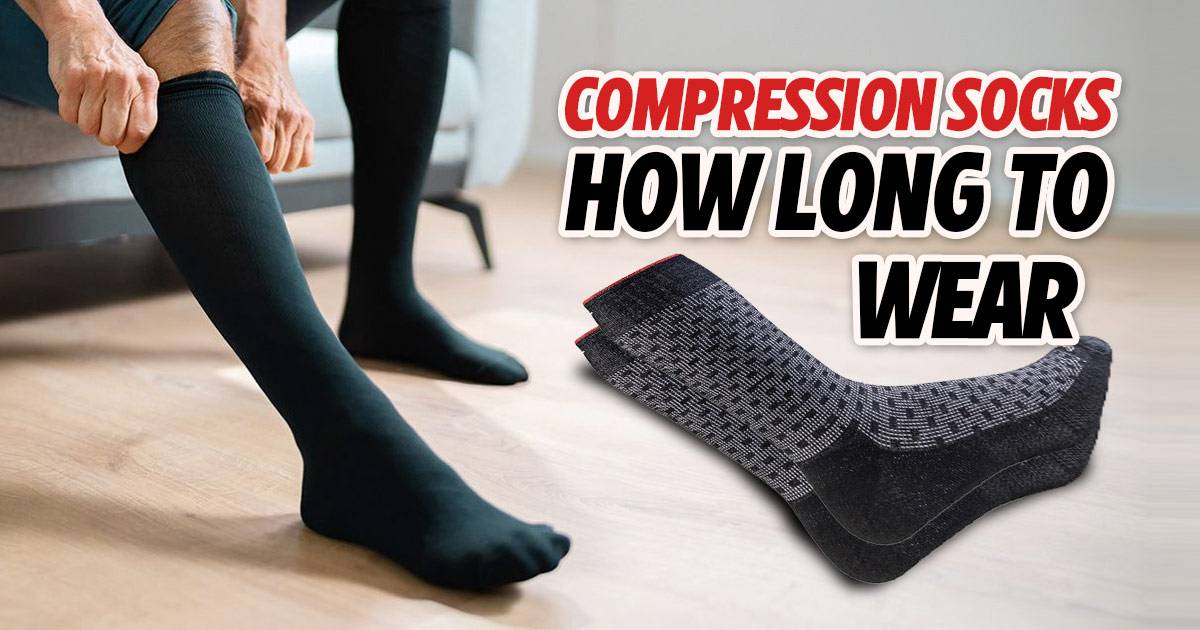Compression Socks: How Long to Wear Them for Optimal Benefits & Safety

Compression socks are a type of hosiery that helps with blood circulation in your legs. They work by gently pressing your lower legs, which helps to push blood back up towards your heart. Individuals with specific medical conditions, athletes, and those who spend extended periods of time standing or sitting can all benefit greatly from these socks.
A study in the Journal of Vascular Surgery found that graduated compression stockings can significantly lower the risk of deep vein thrombosis (DVT) in patients after surgery. Applying external pressure can help compression socks ease the symptoms of various vein and lymphatic issues, making them a great tool for improving circulation.
Doctors often recommend compression socks for those with conditions like varicose veins, lymphedema, chronic venous insufficiency, and DVT. They are also suggested for pregnant women, athletes, people recovering from surgery, or anyone who spends a lot of time on their feet or sitting down.
Benefits of Using Compression Socks
Compression socks provide several advantages that can help improve your comfort and health. Here are some of the key benefits:
- Better Circulation: The blood flowing back to your heart from your legs is improved by wearing these socks. This may lessen the chance of blood clots and other problems with the circulation.
- Reduced Swelling: By applying gentle pressure, compression socks can prevent fluid buildup and reduce swelling in the ankles and feet.
- Pain Relief: By providing support to the affected areas, they can aid in the relief of pain and discomfort brought on by ailments like leg ulcers or varicose veins.
- Prevention of Deep Vein Thrombosis (DVT): Compression socks can reduce the chance of getting DVT, particularly after surgery or during extended periods of inactivity like long flights.
- Enhanced Athletic Performance and Recovery: Through improved oxygen delivery and decreased lactic acid build-up in the muscles, compression socks help athletes minimize muscle soreness, increase performance, and expedite recovery.
- Support Throughout Pregnancy: Due to elevated blood volume and vein pressure, pregnant women frequently have swelling and discomfort in their legs and feet. Compression socks are useful in treating these symptoms.
- Post-Surgical Support: After surgery, wearing compression socks can improve blood circulation and help reduce the risk of complications like blood clots, aiding in a smoother recovery.
Risks Associated with Compression Socks
While compression socks have many benefits, there are also some risks to consider. Here are a few potential downsides:
- Skin Irritation and Allergies: Some people might find that the materials in compression socks irritate their skin. This can cause redness, itching, or even rashes.
- Improper Fit: Wearing socks that don’t fit well can be uncomfortable and may even cause harm. Too-tight socks can worsen sores or swelling by obstructing blood flow rather than promoting it.
- Circulatory Issues: If the compression socks are too tight, they can actually block blood flow. Your legs and feet may experience pain, tingling, or numbness as a result.
- Infections: Not keeping your socks and legs clean can lead to infections. Sweat and bacteria can accumulate and lead to fungal or bacterial infections on the skin.
- Skin Breakdown: Wearing compression socks for too long, especially if they’re too tight, can cause the skin to break down. Those with sensitive skin or pre-existing skin conditions should be especially careful with this.
- Discomfort: Compression socks might feel uncomfortable, especially if worn overnight or in hot weather. This can lead to sweating and skin irritation.
Tips for Using Compression Socks
To get the most out of your compression socks and stay safe, follow these simple tips:
- Talk to Your Doctor: Before you start using compression socks, check with your doctor, especially if you have any health issues.
- Get the Right Fit: Make sure your socks fit well. Measure your legs and use a size chart to find the best size. This helps avoid discomfort and skin problems.
- Start Slow: If you’re not used to compression socks, begin by wearing them for just a few hours each day. Slowly increase the time as you get more comfortable.
- Daily Wear Time: It’s usually recommended to wear compression socks during the day when you are active. Wearing them for about 8-12 hours per day works well for most people.
- Don’t Wear Overnight: Generally, you don’t need to wear compression socks while sleeping unless your doctor says it’s okay. Let your legs breathe at night to prevent irritation.
- Keep Them Clean: Wash your compression socks regularly to keep them clean. Make sure your legs are clean and dry before putting the socks on to prevent infections.
- Watch for Problems: Pay attention to how your legs feel when wearing compression socks. If you notice pain, numbness, or skin changes, take a break and talk to your doctor.
Understanding the Time Limit for Compression Sock Usage
Compression socks can help with pain relief, swelling reduction, and circulation enhancement. To get the best results, make sure to use them correctly. For most people, it is effective to wear compression socks for eight to twelve hours every day. Avoid wearing them overnight unless your doctor recommends it.
To avoid skin issues, make sure your socks fit correctly and maintain their cleanliness. Pay attention to how your legs feel while wearing them, and talk to your doctor if you notice any issues.
You can safely and comfortably reap the benefits of compression socks by paying attention to these easy pointers. Always check with your doctor for advice that’s right for you.
